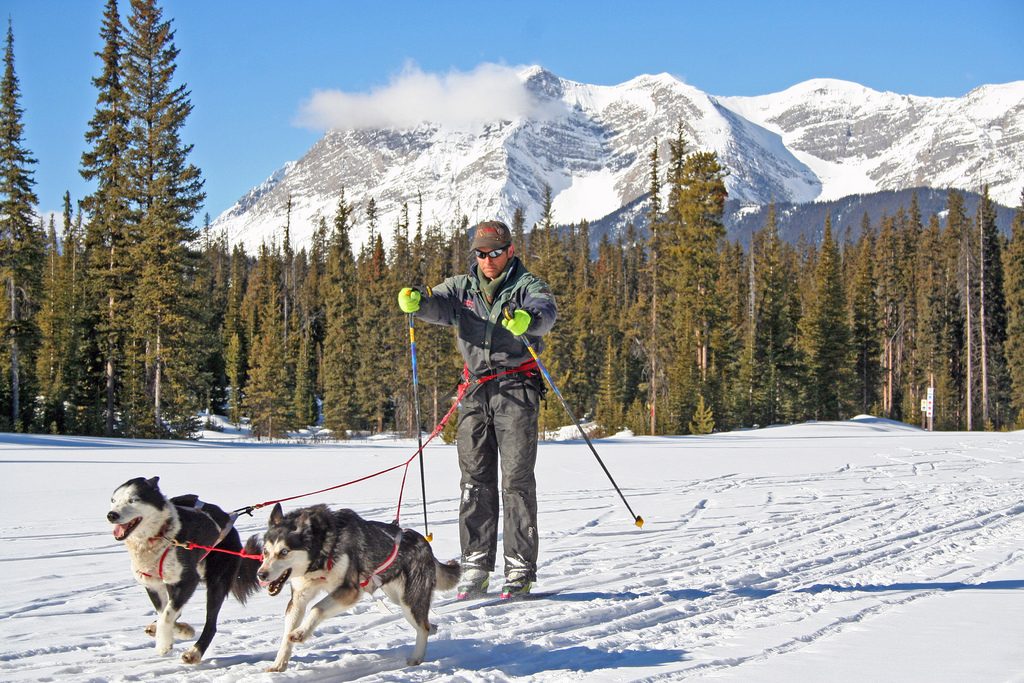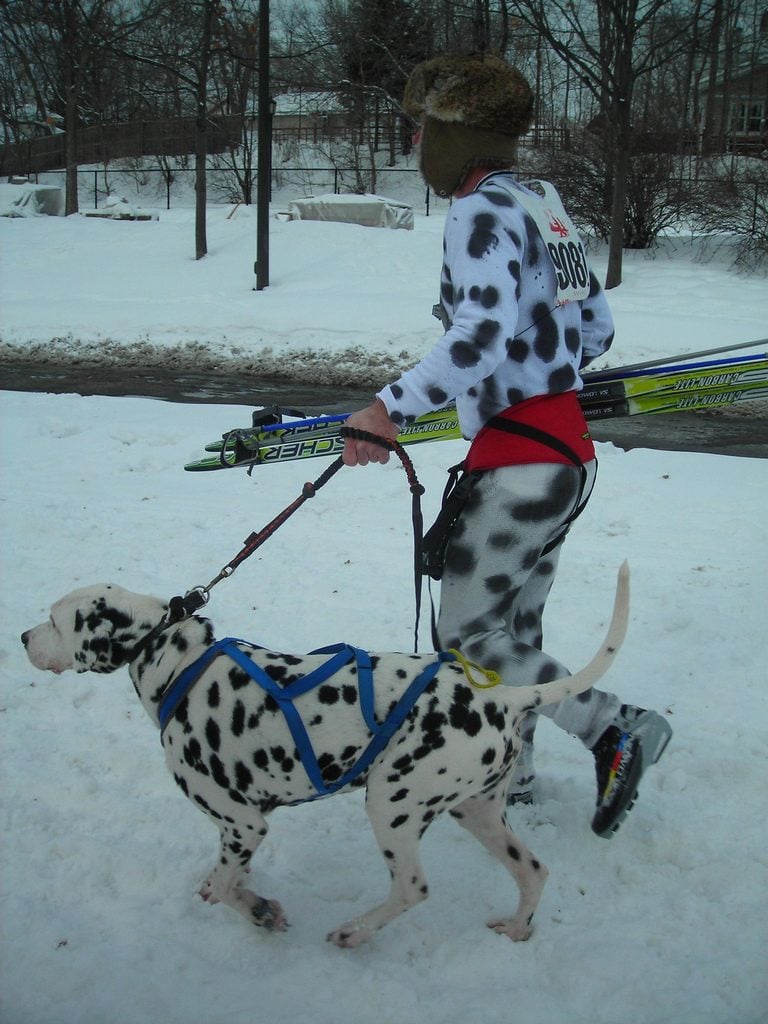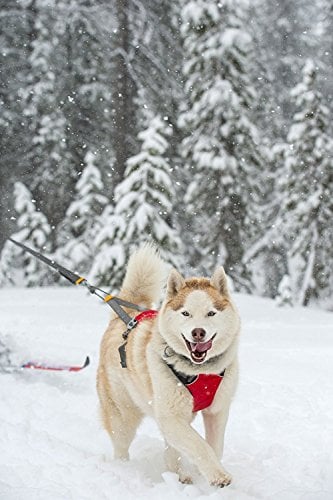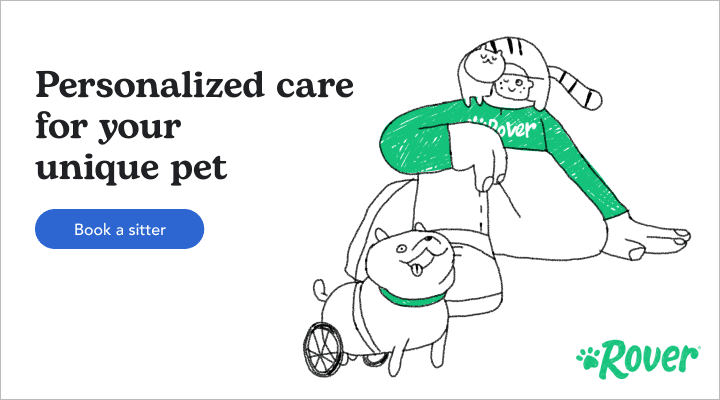- This post contains affiliate links. Read more here.
The air is crisp, snow is blanketing the ground, and we’re deep in the heart of skijoring season, so you know what that means: Time to harness up your dog, strap on your skis, and skijor your little tails off!
Still wondering what the heck “skijoring” is? Okay, we’ll tell you: It’s a wonderful winter dog sport that’s part skiing, part sledding, part dog-walking, part trail running, and 100% fun.
This video from the 2014 Merrill Winterfest Sled Dog Race held in Merrill, Wisconsin serves as a great introduction to the sport:
Dog walking + cross-country skiing = skijoring
“Skijoring” derives from the Norwegian word skikjøring, which literally means “ski driving” (source). At its most basic, the sport is simply cross-country skiing with the aid of a towing agent. You can skijor with a horse or motorized vehicle, but the most popular form is with dogs.
In dog skijoring, also called dog skiing, both dog and human wear harnesses, and are connected to each other by a tow line. The dog runs through the snow, towing the human behind them on skis.
It’s a cousin to sledding, but there are no reins or whips involved. Skijoring depends entirely on the enthusiasm of your dog, and as a recreational dog sport, it’s far easier to learn and practice recreationally than dog sledding.
As SkijorUSA points out, this winter past time “filled with all the romance of dog sledding with the simplicity of walking your dog.” It’s truly is the perfect hybrid starter sport for winter enthusiasts, human and canine alike.
How to tell if your dog was born to skijor
The best skijorers are medium-to-large athletic dogs, but enthusiasm matters far more than breed. If your dog regularly tugs you down the street on her leash and gets the zoomies whenever she sees snow, she may be a great candidate for skijoring.
Of course, common sled dogs breeds have a slight advantage, and many “professional” skijoring dogs are huskies, malamutes, and other hardy cold-weather breeds. But among participants, there’s a wide range of purebreds and mutts with one thing in common: they love to run and tow.
Chances are, you already have a good idea of whether or not your dog is a good fit. As one skijoring dog mom said in an interview with the Spokane Review:
“We knew [our dog] loved to pull and loves snow, so we hoped this activity would be a good fit for her. And, as it turns out, it really showcased what she enjoys.”
To test your dog’s potential, check out some getting-started guides online, like this one from the Pacific Sled Dog and Skijoring Association.
As with any dog sport, your dog’s safety and comfort should be your first priority. If your best friend isn’t down with skijoring, don’t force them or try to incite them along with force. Let the skijor dog take the lead.
Dog skijoring equipment
Okay, so you’re pretty sure your beloved mutt has what it takes to be a skijoring champ. It’s time to get suited up.
Basic skijoring gear includes a harness for your dog, a belt or harness for you, and an 8- to 12-foot shock-corded tug line to connect you. You’ll also need a pair of cross-country skis, and oh yeah, don’t forget to carry a stash of poop bags to keep the ski trail clean!
If you anticipate taking up skijoring as a serious dog sport, you’ll need to invest in a skijoring-specific harness (this beauty from RuffWear has great reviews, and comes complete with a bungee tow line and a human hip belt with pouches to stow baggies, snacks, and a water bottle).
You may also want lightweight winter wear for yourself, and if you’re going to get competitive, you will definitely need high-quality skis. Otherwise, a standard, comfortable set of cross-country skis will work just fine.
But for most of us, skijoring as a hobby doesn’t require a big investment. Start by looking for a skijoring club or lesson in your area. You can always rent a pair of skis, and chances are, you can rent or borrow harnesses and towlines for your first experience.
Hold off on making any big purchases until you know if skijoring will become a lifelong pursuit or an occasional seasonal activity.
Skatejoring for a snowless environment
If you don’t live in a wintery climate, don’t worry: You can always try skatejoring, also known as “urban mushing,” which is skijoring on wheels.
In an interview with the Oregon native, urban mushing expert and skatejoring instructor Liz Parrish explains why ski- and skate-joring are such great activities for dogs:
“Just like people, dogs want a purpose and to participate.”
Skatejoring is very similar to skijoring, but instead of skis, you wear rollerblades or hop on a skateboard. As with the snow sport version, safety is of the utmost importance. Start slow, prioritize your dog’s comfort and fun, and stay away from high-traffic streets.
Of course, nothing beats the original. If you’re lucky enough to live in a winter wonderland, and your dog is raring to run, get out there and skijor.
If you’ve ever skijored, we’d love to hear about it. Leave a comment and tell us all about your dog skiing adventures!
More on Dogs in the Snow
If you love dogs and snow, but have a small or older dog, snowshoeing may be more your speed. You can also check out our video about Jett, an avalanche search and rescue dog at Whitefish Mountain Resort.
Top image via flickr/cichlee




